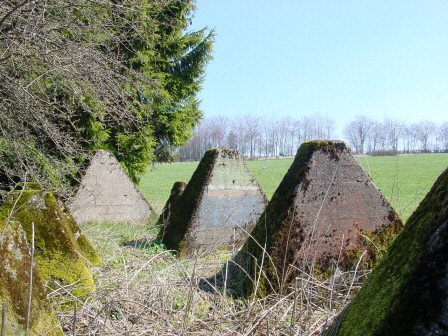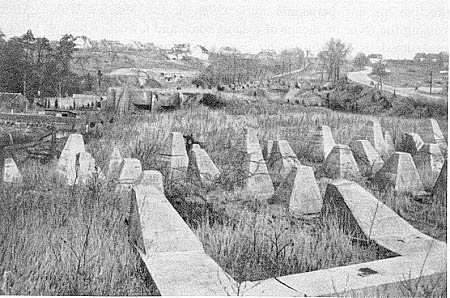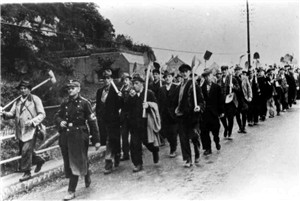
Dragon's teeth at Paustenbach (Hill 554) near Lammersdorf / Simmerath
Following the order of the army's high command on April 7th 1938 to initiate the construction of pillboxes in the Rhineland, around May the building work began along the Belgian-Dutch border in a section of the modern-day state of Northrhine-Westphalia, which in those days belonged to the Rhine province.
This building measure ran under the designation of 'Fortifications Lower Rhine and Eifel'. Some 138 small concrete pillboxes were erected along the border, at cross-roads and on important heights and a main fighting line was reconnoitred further to the rear; this, too, was supposed to be reinforced with individual pillboxes and barriers at endangered points.
Then, on May 28th 1938 Adolf Hitler ordered the enlargement of this main fighting line to a proper line of pillboxes. Within a mere four months almost 12,000 pillboxes were constructed between the Dutch border to the west of the town of Mönchengladbach and the Swiss border in the south.

With the building program 'Fortifications Lower Rhine and Eifel' one had made a start on the erection of a fortified zone along the western border the completion of which, owing to the rationing of steel assignments, was originally planned for 1954. Hitler, however, now demanded the construction upto the beginning of October, the planned target date for the march into Czechoslovakia. From then on it was not the erection of a solid line of pillboxes which was in the foreground, but a fortified zone used as a means of politics and propaganda and which was soon to be known as the 'Westwall'.

Hitler entrusted the building to Fritz Todt, who hitherto had been involved in constructing highways. As a result of his full powers all previous restrictions, such as the fixed quota of steel assignments, disappeared. Todt transferred the organisation of the building, as well as the construction firms, from the highway sites to the western border. The recruitment of hundreds of thousands of workers was regulated by law by means of compulsory conscription.
The pillboxes erected in the construction section called the Limes Program possessed uncomplicated, simplistic ground-plans, in order that they could be built without problem by firms that had had no previous experience of building concrete dug-outs. More difficult structures and pillboxes constructed in the wake of the program 'Fortifications Lower Rhine and Eifel' still had to be taken care of by the military divisions of the 'fortification engineering staff'.
From the fall of 1938 Hitler insisted on the 'Westwall' being advanced nearer to the border and incorporating the cities of Aachen and Saar-briicken within the fortifications. Within the modern state of Northrhine-Westphalia the position was advanced to the bases of the border control under construction since May 1938. This program ran under the name of the Aachen-Saar-Programm.
The airforce, too, built a so-called Air-Defense-Zone West behind the 'Westwall'. At spacious intervals concrete open artillery positions each for a single anti-aircraft battery were built together with concrete shelters for the operating teams and for the storage of ammunition.
At the end of August or early September 1939 the German army occupied the pill-boxes, which by that time had reached the town of Brüggen to the 'West of Mönchengladbach'. Since there was a fear of an outflanking of the fortifications to the north, which would have threatened the industrial region of the Ruhr, the so-called Geldern Line between Brüggen and Kleve (Cleves) on the Lower Rhine was built.

Following the end of hostilities in the west the 'Westwall' had served its function. Everything that was not clinched and riveted was removed from the pillboxes. To some extent the structures still served as air-raid shelters for the civilian population, but a large part of the installations fell into a slumber lasting almost four years. Only after the landing of the Allies in Normandy on June 6th 1944 did one start considering defending the 'Westwall' and reinforcing it by the building of field-works, in particularly of anti-tank ditches. The work began on September 4th 1944, but had to be curtailed after just a week, owing to the outbreak of hostilities. The so-called people's levy withdrawn from the 'Westwall' was mobilized in the course of time to construct a line of defensive positions which developed in the area between the rivers Meuse in The Netherlands and Erft in the present-day state of Northrhine-Westphalia and known under the designation of 'Weststellung'. The employment and guarding of the people's levy lay in the hands of the Nazi party (NSDAP).
On September 12th 1944 American troops penetrated into the 'Westwall' in the south of Aachen, within a few days broke through the line of pillboxes and created a breach in the second line around Stolberg. By March 7th 1945 all pillboxes of the 'Westwall' within modern-day Northrhine-Westphalia were in Allied hands.
Already during the fighting pillboxes were destroyed, others were only later blown up by the Allies. Only some one percent of the structures in Northrhine-Westphalia has survived up to now. The ruins more or less blasted by the demolition parties are even today still being further reduced under the use of considerable public funds, covered with earth and, thus, dealt with for the meantime.
The pillboxes of the 'Westwall' belong to the historical monuments of our recent past and document the historical processes and developments of this period. The buildings characterise the end of the construction of fortifications for the employment of combat weapons such as machine-guns and bazookas under a concrete protection.
Source: Der Westwall
Vom Denkmalwert des Unerfraulichen (see books link)
Further info can be obtained at the following URL:
Siegfried Line at Wikipedia

























Geschichte des Westwalls
Mit dem Einmarsch deutscher Truppen in das entmilitarisierte Rheinland ab dem 7. März 1936 begannen die Planungen der nationalsozialistischen Reichsführung zum Ausbau einer Grenzbefestigung im Westen. Erste Bauten wurden zwischen Mosel und Rhein errichtet. Erst ab März 1938 wurde der Bau von Befestigungen auch entlang der belgischen, niederländischen und luxemburgischen Grenze freigegeben.
Nach Ausgabe des Befehls zum beschleunigten Ausbau der Befestigungsanlagen vom 28. Mai 1938 entstand an der Westgrenze eine bald "Westwall" genannte Bunkerstellung von der Schweizer Grenze bis Brüggen, westlich Viersen. Die Stellung hatte besonders im Abschnitt des Saarlandes eine Tiefe von bis zu mehreren Kilometern, im Rheinland war sie nur östlich von Aachen stärker ausgebaut.
Zur Durchführung dieser Arbeiten waren in der zweiten Jahreshälfte 1938 über 200.000 Arbeiter und 85.000 Männer vom Arbeitsdienst eingesetzt. Im Rheinland waren rund 100 Baufirmen im Bunkerbau tätig. 7.500 LKW brachten das Baumaterial zu den Baustellen; 4.500 Waggons der Reichsbahn transportierten ebenfalls Material für den Bunkerbau, und 3.500 Busse brachten die Arbeiter zu ihren Baustellen.
Göring war in seiner Eigenschaft als Reichsminister für den Vier-Jahres-Plan von Hitler beauftragt worden, diese Aufgabe in Zusammenarbeit mit der militärischen Bauorganisation, den Festungspionieren, der "Organisation Todt" und Zivilunternehmen durchzuführen.
Die Absicht der Reichsführung war, durch den Westwall Deutschland den Rücken für den Einmarsch in die Tschechoslowakei und den Überfall auf Polen freizuhalten. Frankreich als Garantiemacht Polens sollte daran gehindert werden, deutsches Territorium anzugreifen.
Es läßt sich jedoch feststellen, daß der Westwall weniger militärisch als propagandistisch die in ihn gesetzten Erwartungen seiner Erbauer erfüllt hat.
Innenpolitisch diente er einer Arbeitsbeschaffung von großem Ausmaß, wie vor ihm schon der Autobahnbau. Nach außen hin wurde die Befestigungszone von der Propaganda als "steinernes Dokument" einer deutschen "Friedensliebe" gegenüber dem Westen herausgestellt, sollte im Bedarfsfall aber auch zur Abschreckung dienen.
Nach der Eroberung Frankreichs im Juni 1940 hatte der Westwall eigentlich - legt man die Absichten Hitlers zugrunde - seine Schuldigkeit getan. Folgerichtig kam es zu einer Desarmierung der Anlagen und zum Verzicht auf einen weiteren Ausbau.
Als im September 1944 die alliierten Truppen ihre Angriffe auf die Befestigungsanlagen eröffneten, hatte der Westwall weder personell noch materiell den Angreifern etwas entgegenzusetzen. Die desarmierten Anlagen waren nur teilweise mit dem Nötigsten ausgestattet worden. Der Einsatz moderner Panzerabwehrgeschütze (Pak) in den Bunkern war nicht möglich, auch das MG 42 konnte nicht in die Schartentürme eingebaut werden, ebenso fehlten als Nahsicherung der Bunker Minenfelder, Feldstellungen und eine Verdrahtung des Vorfeldes.
Bereits nach wenigen Tagen hatten amerikanische Truppen südlich von Aachen Teile des Westwalls durchbrochen. In der Folgezeit kam es immer wieder zu örtlichen Kämpfen um einzelne Bunkerabschnitte. Der Gegner vermied es, die Stellungen frontal und auf breiter Front anzugreifen. So wurden im Laufe der Zeit der Westwall in jeweils schmalen Abschnitten angegriffen und die Bunker von den Amerikanern zerstört oder besetzt. Am 5. oder 6. März 1945 war auch der letzte von deutschen Gruppen gehaltene Westwallbunker im Abschnitt des heutigen Landes Nordrhein-Westfalen in amerikanischen bzw. englischen Händen.
Der Westwall bestand aus über 14.000 Einzelbauwerken und Panzersperren in Form von Betonhöckerhindernissen, dazu kamen noch Bauten zur Wasserversorgung und Kommunikation.

